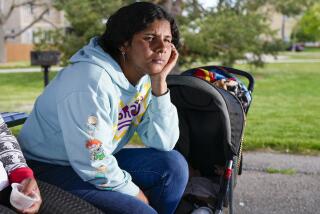Americans Adopting Babies in Peru Face a Nightmare of Court Battles and Bribes
- Share via
LIMA, Peru — Phillip Thomas Shaffer, 4 months old, wriggled in his new mother’s arms, an appealing grin on his face.
He is unaware of the human drama unfolding around him as his mother, Terry, battles court officials and the bureaucracy to adopt him.
Foreigners, most of them from the United States, are coming to Peru in growing numbers to adopt infants, despite sometimes nightmarish problems. Light-skinned foreigners with Indian babies are a common sight in Lima.
“Couples wait for years in the United States,” said an American lawyer who specializes in adoptions in Lima. “Peru is faster.”
Abortions, family planning and a more organized welfare system in the United States turn adoptions into a 5-year process. Most adoptions also involve older children.
During an interview in the American lawyer’s office, the telephone rang every few minutes with calls from new clients. Peru’s appeal has soared since other countries, such as Colombia, made adoptions more difficult.
Phillip is one of thousands of babies offered for adoption by poor, single Peruvian mothers who are unable to feed or educate them.
This poverty-stricken Andean nation of 22 million, mired in its worst economic crisis ever, has discovered it has something many people in other countries want: babies.
Foreign couples, who begin caring for the babies before they are awarded custody, frequently find themselves caught up in complicated legal proceedings. Critics attribute some lengthy adoption cases to court officials seeking bribes.
The American lawyer, who spoke on condition of anonymity, said the process is sometimes slowed by “a sense of national shame that the country can’t support its own children.”
Terry Shaffer, 30 and single, left her home in Ellicott City, Md., four months ago to adopt a child in Peru. Since then, she has lost her job as an epidemiologist and is being supported by her parents.
Her adopted child, Phillip, is from Ayacucho, a remote mountainous region ravaged by a leftist insurgency.
Shaffer had to face formidable paperwork before the adoption process even began: documents certifying her birth and mental and physical health; copies of her passport and tax returns; letters of reference and employment, even FBI assurance that she had no criminal record.
All of it had be translated into Spanish and notarized.
“I gave in everything, but the case took so long we got bogged down, so the judge threw the case out and we started all over again,” Shaffer said.
Linda Carey of Laurel, Md., had an easier time.
Carey, in her 40s and single, took two months to do the paperwork. She now has a 5-month-old daughter, Johanna Elizabeth, from a poor family in Peru’s rural north.
Before a child can be taken to the United States, consular officials in Peru examine the papers to make sure that the adoption is legal.
The American lawyer said a successful adoption in Peru depends on the right combination of judge, lawyer and biological mother.
“Well picked, they can make the adoption a happy, loving experience,” he said. “Badly chosen, they can make it the most emotionally distressing experience you’ve ever had in your life.”
He said lawyers’ fees for adoption cases average $6,000 to $9,000.
“A lot of that goes on wining and dining the judge and bringing the natural mother to Lima, all medical expenses paid,” he said.
Two years ago, American missionaries Ed and Pam Baumgartner, who have lived in Peru eight years, took in four battered children from a broken home in Pucallpa, a jungle town.
When the children, of four different fathers, said they wanted to stay with the Americans, the Baumgartners applied for adoption. That was nine months ago.
“What delayed things is that we refused to bribe a single official,” Pam Baumgartner said.
More to Read
Sign up for Essential California
The most important California stories and recommendations in your inbox every morning.
You may occasionally receive promotional content from the Los Angeles Times.












